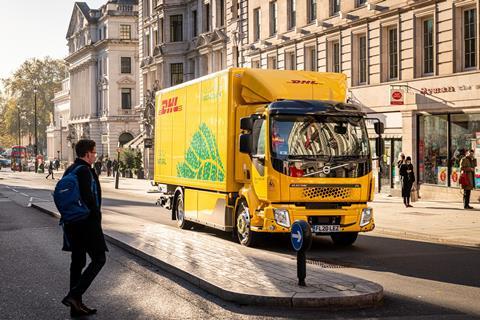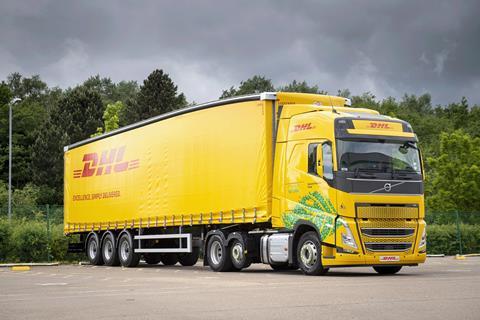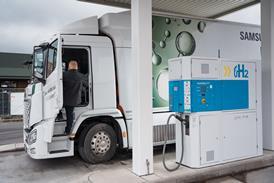As part of our Trailblazer interview series we’re focusing on some of the people who are driving industry decarbonisation. In this interview, we catch up with Katharina Tomoff, DHL Supply Chain’s Senior Vice President Global Environment, Social and Governance and explore how the global contract logistics giant is embarking on a major decarbonisation programme across its fleet.

At the end of last year DHL Supply Chain announced its Green Transport Policy as a global sustainability standard for its own fleet resulting in a €200 million investment programme to transition around 2000 of the vehicles to green alternatives including hydrotreated vegetable oils (HVO), biomethane, electric and hydrogen. By 2026, DHL reckons 30% of its fleet will run on sustainable fuels and drives. This new policy will be implemented across 17 European countries, including the UK and Ireland, and has the potential to save over 300,000 tonnes of CO2 emissions in total for the next three years alone.
What’s more, this is an initiative DHL Supply Chain is driving forward by itself, demonstrating proper leadership in the decarbonisation of the logistics sector. It’s a bold move and breaks with many of the normal conventions of a logistics service provider.
“We wanted to get out of the usual chicken and egg situation where we wait to have a contract with a customer and then say this is how much it is going to cost [to run a low or zero carbon solution] and see whether they are willing to pay. If we continue like this, a mass rollout of green technologies will remain difficult. We wanted to be bold and, yes, show leadership in decarbonization. Of course, we need to commercialise it, we’re not an NGO, but we’re willing to take the risk [of the extra investment] up to a certain level.”

We came across Katharina Tomoff at Smart Freight Week in Amsterdam last year where, in a lively panel discussion, she wasn’t afraid to call out the vehicle manufacturers and infrastructure providers for dragging their feet in developing scalable solutions and gave them a metaphorical poke in the chest. It was clear, DHL and others, were getting frustrated that progress on decarbonisation was being stifled by their rate of progress. That said, DHL remains a key collaborator with the manufacturers as they continue to develop their products.
“I don’t think this is a major revelation to people in the sector, but as we seek to decarbonise, we need three things to come together,” she says. “You have to have the vehicles available; you need to know what you are going to fuel/charge them with, and you need the infrastructure in place to fuel/charge the vehicles. These are the obstacles that have been holding us back.”
Clearly some of those blockages have started to ease, prompting the new strategic direction.
DHL has been testing and trialling different low and zero carbon vehicle solutions for a number of years and, as Tomoff explains, eventually you need to move on from the test phase: “At the beginning of last year, we were at the stage where we’ve been running several pilots and we could have probably continued and carried out larger scale pilots. We took the decision to make a much bigger shift in our ambitions and developed a policy for decarbonising our own fleet.”
As Tomoff says, the current strategy is very much focused on the heavy-duty truck fleet, recognising the company can have a big impact on its carbon emissions through this approach, compared to say the last mile deliveries: “I think we really need to focus our attention on the heavy duty vehicles, because people tend to forget about them a little bit, as we don’t see them as much as the last mile ones. There is a different maturity level of development on the last mile compared to the line haul vehicles. We have over 30,000 electric vans in the fleet as a Group already and we have alternatives such as e-cargo bikes working in the postal sector, so in total that is around a third of the fleet running on green vehicles. This is what we want to achieve for the heavy duty ones as well in the next two years.”
Carbon abatement costs
Embarking on a process to decarbonise your truck fleet isn’t done at the flick of a switch and you won’t be surprised to learn DHL has developed a thorough process to assess and identify where the organisation should be investing to maximise the impact on carbon emissions.
“We carried out a complete review of our transport operations across a number of our main markets,” Tomoff continues. “Initially this was for the top 11 markets accounting for 96% of our own fleet emissions.
“For each of these countries we carried out the assessment, exploring the transport use cases; how many vehicles we operate; the distances involved; whether they are running temperature controlled or super heavy operations. Armed with this information, together with procurement and our engineers, we looked at each country to understand if there is a green alternative available. Meaning whether the three components I mentioned earlier [vehicle type, the fuel/drive and the infrastructure] are available in those markets. If that was the case, then we said, OK, how expensive is it?
“From this we were able to quantify how many Euros it costs to abate a tonne of carbon, based on the choices open to us. We were then able to define a threshold where we said, this is the cut-off point. We’re willing to invest up to this point.” While Tomoff wasn’t able to share with us what the DHL-defined threshold is, she was able to share “we had solutions between €60-1000 per tonne,” she said, adding “the costings and threshold will be reviewed annually.”
Armed with this information, DHL has mandated a course of action across its contract logistics fleet and the focus is now on delivery of solutions. “We’ve said to the organisation, let’s go for it! Let’s have no pilots anymore in mature markets. Let’s deploy at scale,” she explains. “We can now approach our customers, with a scalable, operationally proven and cost-efficient way to decarbonise.”
UK and Ireland
Through the market analysis, DHL has mandated different solutions on a country-by-country basis. In the UK, for example, there have been a lot of mandates “because there is a lot of technology available,” says Tomoff. “For instance, we have switched all our on-site fuelling stations from diesel to HVO. That’s equivalent to about six million litres of fuel every three months. Wherever we can, we want to phase out diesel, for the UK the mandate is for HVO and biogas, because we still don’t have heavy duty electric vehicles at scale available, but we do have some plans there as well.
“In Ireland biomethane is the best option we identified. Together with Tesco, we’re investing into the production of biogas to gradually replace the fleet we run for Tesco with this greener alternatives.”

Transitional solutions
While the end game for the DHL fleet is to be zero emission at the tailpipe, Tomoff remains keen to get going with the available green solutions today. “If we want to act now and have the maximum impact, then we need the bridging solutions such as biogas and HVO,” she says. “Our hope is by the next procurement cycle, in around five years’ time, we will be there [with zero emission vehicles]. That’s my hope.”
In the press release announcing the new decarbonisation strategy, DHL Supply Chain also referenced hydrogen as being part of the mix, we were keen to understand where Tomoff saw it fitting in: “We don’t want to exclude any technologies,” she explained, “but there’s not a single mandate on hydrogen, yet, simply because we don’t have enough use cases or cases where we could actually deploy it at scale.”
No doubt cost, would have meant it sat outside the threshold, as well.
“We have said we would only mandate where the technology is available at scale,” she continues. “We have been piloting and pioneering new technologies throughout the past 15 years and we will continue to do that, in parallel with the roll-out of the Green Transport Policy. There are several technologies, like the e-trailers for instance, which we will, of course, continue to evaluate. We will test it [hydrogen] if it’s an alternative, but I think the main bet currently is on [battery] electric.”
Operational transformation
We’ve always been keen to understand the level of operational transformation required to implement new vehicle and fuel types into a fleet, while maintaining high levels of customer service and operational efficiency. “Designing logistics networks is our core business,” Tomoff explains, indicating this is the least of the concerns for the contract logistics giant, “we should be able to do that, no matter what the fuel type.”
Indeed, she recalls a case study where the company implemented electric vehicles in the early days, but quickly recognised some drawbacks. “It didn’t really work throughout the full delivery chain, so we combined it with rail. Then we could do one leg rail and one shorter leg with electric. That brought down the emissions significantly for all parties. Our operations teams will be designing systems to make it seamless for the customer and while we may have to cut our routes differently in order to charge the truck and have that load going exactly where it needs to go, it’s feasible,” she says.
Sub-contractors
Sub-contractors have a major part to play in delivering road freight logistics throughout Europe and that’s no different at DHL. The current DHL programme covers the company’s owned fleet, as we have said, but clearly third-party sub-contractors will have a big part to play in reducing the carbon footprint across DHL’s logistics contracts. Subbies will fall within DHL’s Scope3 emissions, but as Tomoff explains “Scope 3 emissions are part of our targets. We have never distinguished between the different scopes, because as we see it, we provide transport and it’s our decision whether we do this with our own vehicles or with a subcontractor. We have launched our mandatory programme for our own vehicles first, to show that it works so we can partner also with our subcontractors in the future to also green their fleets.
“We’re currently working on what the models would need to look like for our sub-contractors to make these investments. Do they need a longer contract cycle, for instance, or do we need a cost share? This needs to be a collaboration between the subcontractor, us and the customer.”
In making its bold step forward, DHL Supply Chain has raised the stakes among its competitors and declared its intent to the market. It’s time now for the customers to put their money where their net zero mouths are and demonstrate similar leadership. For the suppliers, too, it’s a signal DHL means business and is in a position to make long-term commitments to the vehicle, fuel and infrastructure suppliers. This is a brave move by DHL and not without risks, but sooner or later this is the step all commercial vehicle operators are going to have to take.
“The time to act is now and where we can, we should,” concludes Tomoff. “We are demonstrating we can go beyond pilots and make a significant difference to our carbon emissions through our coordinated approach. Through this we’re able to support and partner with our customers on their decarbonisation journey.”













